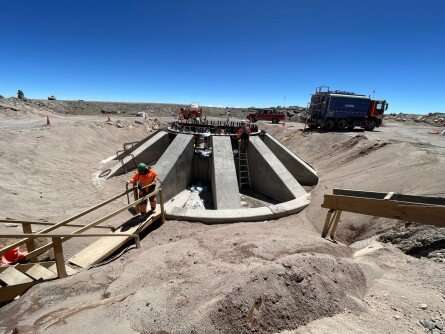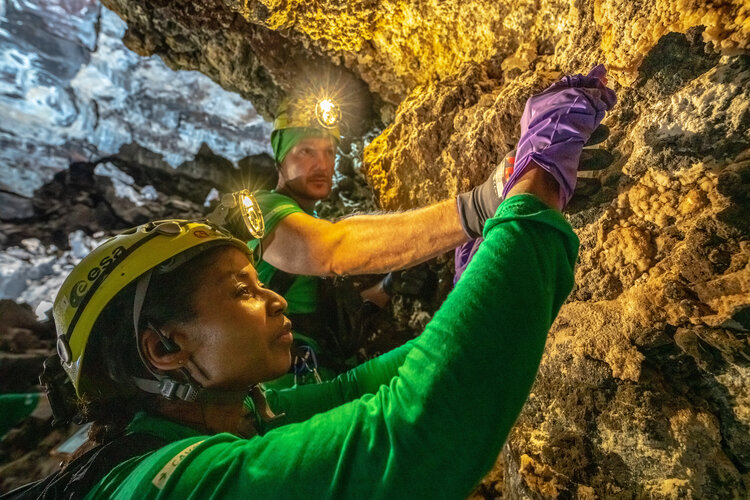
Copernical Team
Curious comet’s rare close approach

Turning astronauts into Moon explorers
Astral alchemy
 The Standard Model of particle physics tells us that most particles we observe are made up of combinations of just six types of fundamental entities called quarks. However, there are still many mysteries, one of which is an exotic, but very short-lived, Lambda resonance known as ^(1405).
For a long time, it was thought to be a particular excited state of three quarks-up, down, and strange-
The Standard Model of particle physics tells us that most particles we observe are made up of combinations of just six types of fundamental entities called quarks. However, there are still many mysteries, one of which is an exotic, but very short-lived, Lambda resonance known as ^(1405).
For a long time, it was thought to be a particular excited state of three quarks-up, down, and strange- Setting sail for safer space
 Image:
Setting sail for safer space
Image:
Setting sail for safer space New telescope project completion in sight

The construction of the Fred Young Submillimeter Telescope (FYST) being developed by CCAT Observatory Inc., an international consortium of universities led by Cornell, is drawing to a close.
Work is poised to begin on a defining feature of the telescope—the "elevation" part that supports the upper structure and will contain the telescope's mirrors. Unlike almost any other telescope to date, the part will be constructed from Invar, a special formulation of steel that has an extremely low coefficient of thermal expansion.
"This means that it doesn't get bigger when it's hot and it doesn't shrink when it's cold," said Jim Blair, FYST project manager in the Department of Astronomy, in the College of Arts and Sciences. "At least, it's greatly, greatly reduced with Invar compared to regular steel. And that's important for the science, because at the wavelengths we are looking at, thermal expansion would actually affect the data and could ruin it.
Studies on hibernating squirrels may help astronauts
 Can studying sleeping Arctic ground squirrels help astronauts and further NASA's mission? Dr. Kelly Drew and her students studied hibernating squirrels and their ability to retain muscle and bone mass during extended hibernation and they think it could apply to astronauts.
Drew, a professor of chemistry and biochemistry at the University of Alaska, Fairbanks in Fairbanks, Alaska was awarde
Can studying sleeping Arctic ground squirrels help astronauts and further NASA's mission? Dr. Kelly Drew and her students studied hibernating squirrels and their ability to retain muscle and bone mass during extended hibernation and they think it could apply to astronauts.
Drew, a professor of chemistry and biochemistry at the University of Alaska, Fairbanks in Fairbanks, Alaska was awarde D-Orbit launches ION's first mission into a midinclination orbit
 Space logistics and orbital transportation company D-Orbit launched Starfield, the eighth commercial mission of their proprietary orbital transfer vehicle (OTV) ION Satellite Carrier (ION), and the first one in a midinclination orbit.
The OTV lifted off January 31st, 2023, at 8:15 a.m. PT (16:15 UTC) aboard a Falcon 9 rocket from the Space Launch Complex 4 East (SLC-4E) at Vandenberg Space
Space logistics and orbital transportation company D-Orbit launched Starfield, the eighth commercial mission of their proprietary orbital transfer vehicle (OTV) ION Satellite Carrier (ION), and the first one in a midinclination orbit.
The OTV lifted off January 31st, 2023, at 8:15 a.m. PT (16:15 UTC) aboard a Falcon 9 rocket from the Space Launch Complex 4 East (SLC-4E) at Vandenberg Space Iridium GO exec redefines personal off-the-grid connectivity
 Iridium Communications (Nasdaq: IRDM) has unveiled the most capable, ultra-portable solution for truly global connections to all smartphones, tablets and laptops - a new class of personal satellite communication device called the Iridium GO! exec. Built for the professional but made for everyone, the Iridium GO! exec provides a natural extension of your world off-the-grid to send and receive ema
Iridium Communications (Nasdaq: IRDM) has unveiled the most capable, ultra-portable solution for truly global connections to all smartphones, tablets and laptops - a new class of personal satellite communication device called the Iridium GO! exec. Built for the professional but made for everyone, the Iridium GO! exec provides a natural extension of your world off-the-grid to send and receive ema ATLAS works with AWS to advance federated network and expand ground station coverage
 ATLAS Space Operations, a leading Ground Software as a Service (GSaaS) provider, has announced that it is the first provider to join the Amazon Web Services (AWS) Solution Provider Program (SPP) to resell AWS Ground Station, a fully managed ground station infrastructure which lets customers control satellite communications, process data, and scale their operations.
The SPP is an official A
ATLAS Space Operations, a leading Ground Software as a Service (GSaaS) provider, has announced that it is the first provider to join the Amazon Web Services (AWS) Solution Provider Program (SPP) to resell AWS Ground Station, a fully managed ground station infrastructure which lets customers control satellite communications, process data, and scale their operations.
The SPP is an official A Lockheed Martin's first LM 400 Multi-Mission Spacecraft completed
 The first Lockheed Martin (NYSE: LMT) LM 400, a flexible, mid-sized satellite customizable for military, civil or commercial users, rolled off the company's digital factory production line and is advancing toward its planned 2023 launch.
The agile LM 400 spacecraft bus design enables one platform to support multiple missions, including remote sensing, communications, imaging, radar and per
The first Lockheed Martin (NYSE: LMT) LM 400, a flexible, mid-sized satellite customizable for military, civil or commercial users, rolled off the company's digital factory production line and is advancing toward its planned 2023 launch.
The agile LM 400 spacecraft bus design enables one platform to support multiple missions, including remote sensing, communications, imaging, radar and per 

